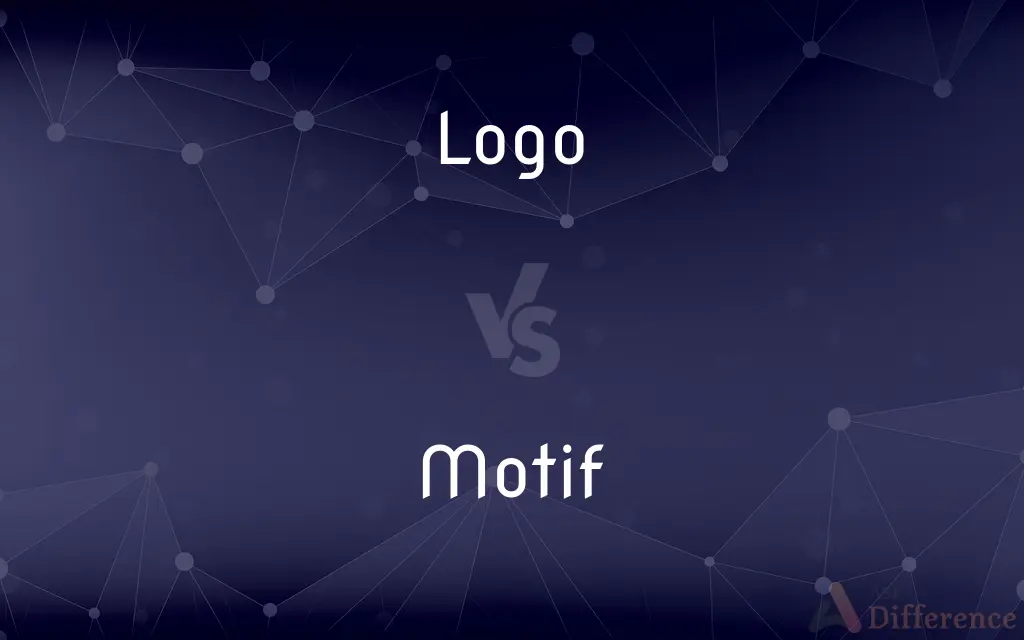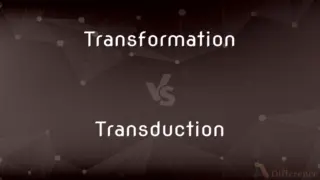Logo vs. Motif — What's the Difference?
By Tayyaba Rehman & Urooj Arif — Updated on April 4, 2024
A logo is a distinctive symbol representing a company or brand, focusing on identity and recognition, while a motif is a recurring theme, element, or idea in art, adding depth and cohesion.

Difference Between Logo and Motif
Table of Contents
ADVERTISEMENT
Key Differences
A logo serves as a visual identifier for businesses, brands, or products, crafted to be memorable and recognizable at a glance. Whereas a motif, in contrast, is a repeated design or thematic element that appears across various works of art or within a single piece, contributing to its meaning or aesthetic.
Logos are often the result of strategic branding efforts, combining colors, shapes, and sometimes text to convey a company's values, mission, or personality. On the other hand, motifs can be visual, such as a repeated pattern in a textile design, or conceptual, like the recurrent themes of love and betrayal in a literary work, enriching the viewer's or reader's experience by adding layers of meaning.
The development of a logo involves careful consideration of market positioning, target audience, and the overall messaging the brand wishes to communicate. In contrast, the use of motifs may evolve naturally within a creative process, serving to unify disparate elements and reinforce the work's thematic or aesthetic coherence.
While logos are primarily used in commercial contexts to aid in marketing and brand recognition, motifs play a broader role across various forms of art and design, including literature, visual arts, architecture, and fashion, serving both decorative and symbolic functions.
Despite their differences, both logos and motifs hold significant power in their respective fields. A well-designed logo can elevate a brand's visibility and recognition, while an effectively used motif can deepen the meaning and enhance the unity of an artistic work. However, the intent behind their creation and their application distinguishes them fundamentally.
ADVERTISEMENT
Comparison Chart
Definition
A graphic mark or emblem used to identify a company, brand, or product.
A recurring theme, element, or idea in art, contributing to its unity and meaning.
Purpose
To represent and promote a brand or company.
To add depth, meaning, or aesthetic cohesion to a work of art.
Usage
In business, marketing, and branding.
In various forms of art, including literature, visual arts, and design.
Creation
Involves strategic design reflecting brand identity.
May evolve naturally or be deliberately employed within a creative process.
Function
Commercial and promotional, aimed at recognition and recall.
Symbolic or decorative, enhancing thematic or visual unity.
Compare with Definitions
Logo
A unique symbol or design representing a company.
The new startup unveiled its logo at the launch event.
Motif
Can be visual, like a pattern, or thematic, like a concept.
The floral motif is prevalent in her textile designs.
Logo
Aids in brand recognition and loyalty.
Their logo is so iconic that it instantly reminds you of their products.
Motif
A recurring element with symbolic significance in art.
The motif of water in the novel symbolizes renewal.
Logo
Evolves with the brand’s identity and market position.
The corporation updated its logo to reflect its new environmental focus.
Motif
Enhances the cohesion and depth of a work.
The recurring motif of flight ties the collection's pieces together.
Logo
Often incorporates the company’s name or initials.
The fashion brand’s logo is a stylized version of its founder's initials.
Motif
Varied applications across literature, music, and visual arts.
The motif of darkness and light pervades the composer’s works.
Logo
Can be abstract or literal in its depiction.
The software company’s logo abstractly represents connectivity.
Motif
Reflects the creator’s artistic intentions and message.
The use of a bird motif throughout the film underscores themes of freedom.
Logo
A logo (abbreviation of logotype, from Greek: λόγος, romanized: logos, lit. 'word' and Greek: τύπος, romanized: typos, lit. 'imprint') is a graphic mark, emblem, or symbol used to aid and promote public identification and recognition. It may be of an abstract or figurative design or include the text of the name it represents as in a wordmark.
Motif
A recurrent thematic element in an artistic or literary work.
Logo
A symbol or other small design adopted by an organization to identify its products, uniform, vehicles, etc.
The Olympic logo was emblazoned across the tracksuits
Motif
A dominant theme or central idea.
Logo
A symbol or design that identifies a brand.
Motif
(Music) A short rhythmic or melodic passage that is repeated or evoked in various parts of a composition.
Logo
A visual symbol or emblem that acts as a trademark or a means of identification of a company or organization.
Motif
A repeated figure or design in architecture or decoration.
Logo
(by extension) An audio recording for the same purpose; a jingle.
Motif
A recurrent pattern either of molecular sequence, usually of nucleotides or amino acids in proteins, or of molecular structure that usually corresponds to specific biological activity.
Logo
(science) A single graphic which contains one or more separate elements.
Motif
A recurring or dominant element; an artistic theme.
See how the artist repeats the scroll motif throughout the work?
Logo
An ensign, a badge of office, rank, or power.
Motif
(music) A short melodic or lyrical passage that is repeated in several parts of a work.
Logo
A company emblem or device
Motif
A decorative figure that is repeated in a design or pattern.
Motif
(dressmaking) A decorative appliqué design or figure, as of lace or velvet, used in trimming.
Motif
(crystallography) The physical object or objects repeated at each point of a lattice. Usually atoms or molecules.
Motif
(chess) A basic element of a move in terms of why the piece moves and how it supports the fulfilment of a stipulation.
Motif
(biochemistry) In a nucleotide or aminoacid sequence, pattern that is widespread and has, or is conjectured to have, a biological significance.
Motif
Motive.
Motif
In literature and the fine arts, a salient feature or element of a composition or work; esp., the theme, or central or dominant feature;
This motif, of old things lost, is a favorite one for the serious ballade.
The design . . . is . . . based on the peacock - a motif favored by decorative artists of all ages.
Motif
A decorative appliqué design or figure, as of lace or velvet, used in trimming; also, a repeated design.
Motif
A design that consists of recurring shapes or colors
Motif
A theme that is elaborated on in a piece of music
Motif
A unifying idea that is a recurrent element in a literary or artistic work;
It was the usual `boy gets girl' theme
Common Curiosities
What is a motif?
A motif is a recurring theme, element, or idea that appears in artistic work, adding depth or unity.
How do logos and motifs differ in purpose?
Logos are aimed at branding and marketing, while motifs enhance artistic cohesion and meaning.
What is a logo?
A logo is a distinctive symbol designed to represent and identify a company, brand, or product.
Are logos always visual?
Logos are primarily visual, but they can also include text elements like names or slogans.
How do logos impact consumer behavior?
A well-designed logo can influence consumer perceptions and decisions, enhancing brand loyalty and recognition.
Can motifs be found in commercial designs?
Yes, motifs can be employed in commercial designs to create a unified aesthetic or brand identity.
Can the same motif appear in different works?
Yes, a motif can recur across various works, often to evoke similar themes or emotions.
How does a motif contribute to literature?
In literature, a motif reinforces themes or character development, enriching the narrative.
Is the design of a logo influenced by current trends?
Yes, logo designs can be influenced by trends, but they also strive for timelessness to maintain brand identity.
Can a logo contain motifs?
A logo can incorporate motifs, especially if they are central to the brand’s identity or story.
How are logos and motifs developed?
Logos are developed through a strategic design process, while motifs may emerge naturally or be deliberately incorporated into creative works.
How do motifs enhance the viewer's or reader's experience?
Motifs create deeper layers of meaning, making the art more engaging and resonant.
Do motifs change over time?
While a specific work's motifs typically remain constant, the interpretation and use of motifs can evolve over time.
What is the significance of color in logos and motifs?
Color can convey emotions and associations, playing a crucial role in both logos and motifs for branding and thematic purposes.
Why are motifs important in film and television?
In film and television, motifs help in building narrative consistency and deepening thematic exploration.
Share Your Discovery

Previous Comparison
Transformation vs. Transduction
Next Comparison
Workstation vs. DesktopAuthor Spotlight
Written by
Tayyaba RehmanTayyaba Rehman is a distinguished writer, currently serving as a primary contributor to askdifference.com. As a researcher in semantics and etymology, Tayyaba's passion for the complexity of languages and their distinctions has found a perfect home on the platform. Tayyaba delves into the intricacies of language, distinguishing between commonly confused words and phrases, thereby providing clarity for readers worldwide.
Co-written by
Urooj ArifUrooj is a skilled content writer at Ask Difference, known for her exceptional ability to simplify complex topics into engaging and informative content. With a passion for research and a flair for clear, concise writing, she consistently delivers articles that resonate with our diverse audience.














































